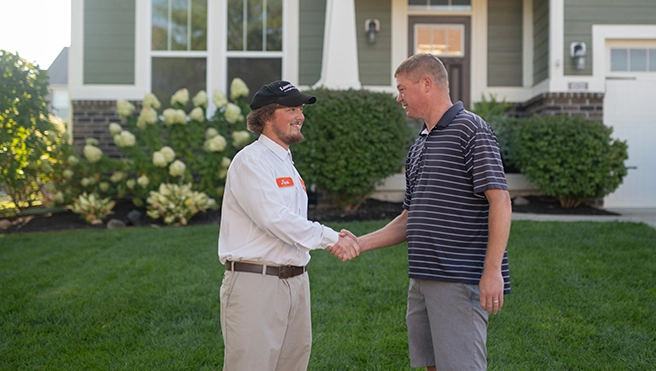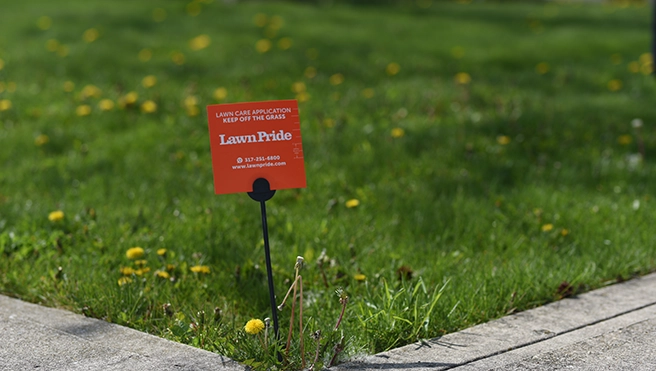The Heat is On! Increased temperatures and changing weather can affect your lawn. This means you will need to change the way you maintain your lawn. Don’t worry, our experts are here to help!
Summer Lawn Care Tips
How to maintain your lawn during the summer!

Summer Mowing Recommendations

Summer Watering Recommendations
Your lawn needs water to thrive and survive. Watering too little or too much can harm your lawn. Your Lawn Pride experts are here to help you find that balance.
When to Water
The best time to water your lawn is in the early morning hours twice a week. Watering in the middle of the day with high temperatures can cause the water to evaporate too quickly. This will prevent the water from absorbing into the soil. If needed you can water your lawn in the early evening hours; however, make sure the lawn has time to soak up the water. Letting too much water sit on the lawn overnight can lead to turf disease.
How to Water
If you are a homeowner with the convenience of an in-ground irrigation system; watering is as easy as making sure you are programing your system correctly. However, not all homeowners have it that easy. Your lawn needs 1-1.5 inches of water per week. Natural rain will do the trick, but it’s important to monitor your grass and water when mother nature isn’t providing your lawn with what it needs. This is about the equivalent of watering for thirty minutes twice a week.
Drought Stress
Watering your lawn can be costly especially during long periods of hot, dry weather. Try to water your lawn at least twice a week for thirty to forty-five minutes. Your lawn may still look dry, but this is because the lawn will try to protect itself by going dormant when it doesn’t get the amount of water and nutrients it needs. By watering this small amount every week, it will help to sustain the root system until the weather turns around. This method is much cheaper than having to rebuild your lawn.
Heat Stress
Cement, brick, and other types of landscape edging can hold heat causing the grass to brown out along the edges. Increasing watering time in these areas by 15 minutes can help prevent heat damage along the edges.
For more watering tips, check out our watering recommendations for Central Indiana lawns.
Fertilizing During Hot, Dry Periods
During periods of high temperatures and low amounts of precipitation; lawns in Central Indiana will start to go dormant. This is a defense mechanism. By going dormant, the grass holds its nutrients in the root system instead of releasing it to the grass blades. It is important during these times to maintain regular fertilizer applications and to manually water the lawn when mother nature isn’t doing it for us. Fertilizing your lawn is important in maintaining density, encouraging root growth, and recovering your lawn from turf damage and seasonal turf stress (such as hot, dry periods). Applying the right fertilizer at the correct time helps turf accumulate and store essential nutrients it needs for proper growth and development.

Hard to Control Weeds
Not all weeds are the same. While some weeds thrive in cool temperatures others thrive in the heat. Some need very little water and others need excessive water. Our broadleaf weed control can kill most weeds with one application. Some more mature or stubborn weeds may take a couple of applications. Some weeds can only be killed off at specific times of the year. Here are a few easy steps to help get the most out of your lawn:
Maintain consistent lawn applications
Long delays between applications can cause weeds to be harder to kill and maintain. Also, delaying fertilization can stress your lawn’s root system causing thinning and giving weeds move room to grow.
Don’t mow the lawn too short
Central Indiana lawns should be mowed at 3.5 - 4 inches. Mowing short can expose the root system, drying them out and paving the way for weeds to grow.
Seed thin lawns
Weeds can only grow where there is room. If your lawn is thin, aerate and seed in the fall. This will thicken up the lawn giving less room for weeds to germinate.
Call us
If you are a Lawn Pride customer and you take at least five lawn applications each season; you qualify for a free weed touch-up for up to 14 days after your lawn care application.
For more information on weeds and how to control them. Check out our guide to Common Central Indiana Weeds.

Grub Watch
Be on the lookout! Beetles lay their eggs between June and August. When the grubs emerge from their eggs, they are hungry and can destroy your lawn. If you see an increase of beetle activity in or around your lawn, then you should have a preventative Grub Control Program. A preventative Grub Control Program will protect your lawn against possible grub damage. Click here to learn more about Grubs Worms.
Lawn Fungus
Summer weather conditions can provide turf diseases the perfect environment needed to infect your lawn. Diseases like Brown Patch and Summer Patch are common types of fungus that thrive in the warm, humid weather conditions that Central Indiana can experience in the Summer months. Luckily there are some lawn care practices that can go a long way toward the prevention of turf diseases. This includes:
- Choosing disease-resistant grass such as Turf Type Tall Fescue.
- Mowing frequently at a 3.5 to 4-inches (removing no more than 1/3 of the grass blade at a time).
- Make sure your lawn gets 1-1.5 inches of water per week and water early in the morning whenever possible (giving time for grass blades to dry during the day).
- Aerate the lawn to allow proper nutrient absorption and break up the thatch layer (where disease spores can live).
See our guide to Common Lawn Fungus in Central Indiana to learn more.
Landscaping and Garden Care
We spend a lot of time promoting proper lawn care, but in addition to grass, your property likely has added vegetation, such as trees and shrubs, flowers, and possibly a small garden for your favorite fruits, veggies, and herbs. All of which will also appreciate your care and attention. So grab your gardening gloves and get to work in order to create an all-around beautiful yard.
- Prune shrubs and take care of dead or damaged branches (along with those limbs looming a bit too close to your roof).
- Divide and replant overgrown plants when possible.
- Fertilize plants to promote strong, healthy growth.
- Carefully pluck weeds hiding in between plants.
- Lay down healthy beds of mulch or pine straw to help retain moisture.
- And, don’t forget to water those pots, hanging baskets, and window boxes.
At Lawn Pride, we strive to protect not only your turf but also your plants and trees! Learn more about our Tree and Shrub Program in order to keep your entire lawn and landscape healthy throughout the entire season.
Summer Pest Control
From creepy crawlers and mosquitoes to tiny grubs, fleas, and ticks, or even moles and voles, lawn pests come in all shapes and sizes (and cause lasting damage or destruction to your yard!) What’s a homeowner to do? While you won’t be able to eliminate 100 percent of pests from your lawn, there are plenty of DIY and professional steps you can take to prevent most of them.
Perimeter Pest Control
Each spring, ants, spiders, and other pests march from your yard to your home. Our Perimeter Pest Control treatment is applied around the perimeter of your house to keep these creepy crawlers outside where they belong. Learn more about common Indiana pests to know how to prevent them.
Critter Control
There are different strategies for furrier critters. You can catch animals such as moles, mice, and raccoons in traps. Our mole and vole control solutions will do the trick! Love birds more than squirrels? Remember to take the necessary precautions when setting up bird feeders around your property or add in a specialty squirrel feeder or two as well.
Call in the Pros
All these different chores can seem like a lot for the average homeowner. With work, family, and other obligations, sometimes you just need a helping hand. Thankfully, there’s one important turf tip that can help relieve the burden… US! Take a look at our long list of expert lawn care services. We can help you improve the lawn and your outdoor living space.
Commonly Asked Questions
Our Special Offers
We understand your goal to keep your lawn looking its best. We take pride in your lawn because we know you do, too. Check out our special offers to see how you can save on your next lawn care application.
